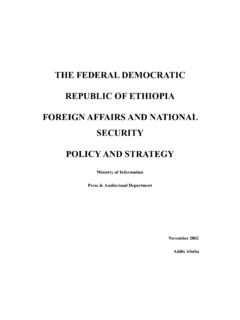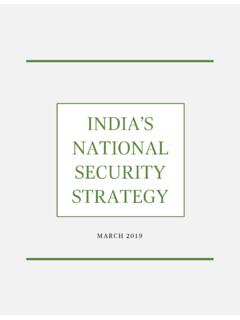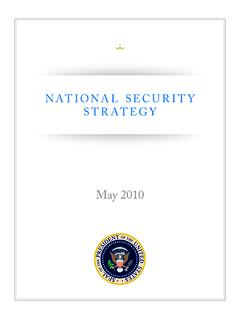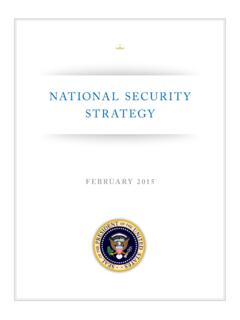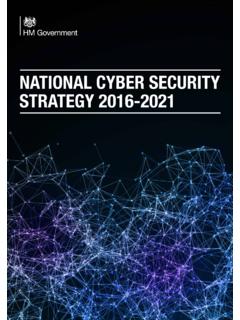Transcription of National CYBER SECURITY POLICY 2021 - moitt.gov.pk
1 National CYBER SECURITY POLICY 2021 National CYBER SECURITY POLICY 2021 JULY, 2021 MINISTRY OF INFORMATION TECHNOLOGY & TELECOMMUNICATION Government of Pakistan National CYBER SECURITY POLICY 2021 Table of Contents Background _____ 1 Introduction _____ 1 Review of Pakistan s CYBER SECURITY Landscape _____ 2 Challenges and risks _____ 3 Ownership at the Top _____ 3 Governance and Implementation challenges of CYBER SECURITY POLICY and strategy 3 Enforcement of Required Structures and Processes _____ 4 Course of Action _____ 5 Vision, Scope & Objectives _____ 6 Vision _____ 6 Scope _____ 6 Objectives _____ 6 Principles _____ 7 POLICY Deliverables _____ 8 CYBER SECURITY Governance _____ 8 POLICY Formulation and Oversight.
2 CYBER Governance POLICY Committee (CGPC)8 Institutional Structure for Implementation _____ 9 Active Defence _____ 9 Protecting Internet-Based Services _____ 10 Protection and Resilience of National Critical Information Infrastructure __ 10 Protection of Government s Information Systems and Infrastructure _____ 11 Information SECURITY Assurance Framework _____ 12 Public-Private Partnership _____ 13 CYBER SECURITY Research and Development _____ 13 Capacity Building _____ 14 Awareness for National Culture of CYBER SECURITY _____ 14 Global cooperation and Collaborations _____ 15 Cybercrime Response Mechanism _____ 16 Regulations _____ 16 Establishing Trust In Digital Transactions _____ 17 Improve Pakistan s ICT Ranking _____ 17 Risk management and Risk-based
3 Approach _____ 17 Appendix Glossary of terms _____ 18 National CYBER SECURITY POLICY 2021 Interim Measures _____ 18 POLICY Review and Implementation _____ 19 National CYBER SECURITY POLICY 2021 1 Background INTRODUCTION Information and Communication Technologies (ICTs) have played a key role in revolutionizing the world, making it truly a Global Village within the last decade. The innovation in Information and Communication Technology is redefining the dimension of socio-economic development in the world, resulting in commercial, economic, cultural, and social opportunities for users of Cyberspace. This unprecedented growth has ushered in a new era, marked with easy and low-cost access to highly interconnected networks around the globe.
4 With the developments in the ICTs, and reliance on Broadband infrastructure, in particular, the Internet has taken center in today s modern world. The world is now increasingly interconnected and people have unprecedented access to information and knowledge. To harness the benefits of ICT technologies and the Fourth Industrial Revolution (4IR), Pakistan has also adopted the path of Digital Transformation. The increased use of information and communication technologies enhanced global connectivity, mobility, and versatility of digital services exposes information assets to a host of new and evolving CYBER SECURITY threats. The Fourth Industrial Revolution has made these assets highly valuable. However, with the organic growth and proliferation of the Internet, some worrisome trends in the use of cyberspace have also emerged.
5 The concerns over safety and SECURITY potentially impede the objective of accelerated development and affect the confidence of people in using applications and services offered to traverse cyberspace. The rise in incidents related to malicious use of ICTs in cyberspace is affecting the integrity and the civil rights protections guaranteed by the state, level-playing field, transparency, and the socio-economic equilibrium by posing SECURITY and financial risks to the whole spectrum of users including Individuals, Businesses, Sectors, and States and could potentially impose serious barriers to achieving development goals in various economic sectors. National CYBER SECURITY POLICY 2021 2 REVIEW OF PAKISTAN S CYBER SECURITY LANDSCAPE In order to ensure the online safety of the citizens of Pakistan and to ensure the SECURITY of the digital systems, various initiatives are already in place by different federal & provincial bodies and sectoral regulators under the enactments such as the Electronic Transaction Ordinance, 2002 (covering only electronic financial transactions and records), Investigation for Fair Trial Act (IFTA) 2013, Pakistan Telecommunication (Re-Organization) Act - 1996 and Prevention of Electronic Crime Act (PECA) 2016 which cover some but not all aspects of information and CYBER SECURITY .
6 In addition, the State Bank of Pakistan (SBP) issues guidelines on CYBER SECURITY for the financial sector, and the PTA has notified the Telecom Computer Emergency Response Team (CERT). However, the inter-departmental coordination and holistic approach to address the CYBER SECURITY challenges and their emerging trends requires a special focus on a National level. With regards to setups responsible for CYBER SECURITY in the country, only the selective CYBER SECURITY Incident Response Teams (CSIRTs) are operational at the organizational level in the public, private, and defense sectors. However, there is a need to enhance existing legislative and institutional frameworks, and strengthen the principal, organization, mandated for National CYBER SECURITY .
7 The legal framework, structures, and processes related to CYBER SECURITY need to be constantly monitored, assessed, and improved. To undertake academic research, National Center for CYBER SECURITY was established in 2018. The HEC has also formulated new academic degrees that include BS, MS, and CYBER SECURITY and MS Systems SECURITY programs. However, the demand and supply gap for digital skills in general and CYBER SECURITY , in particular, is ever-increasing, which underscores the importance of upskilling the existing resources. In the absence of an indigenous National ICT and CYBER SECURITY industry, Pakistan relies heavily on imported hardware, software, and services. This reliance, inadequate National SECURITY standards, and weak accreditation National CYBER SECURITY POLICY 2021 3 has made computer systems in Pakistan vulnerable to outsider cyberattacks and data breaches through embedded malwares, backdoors, and chipsets.
8 CHALLENGES AND RISKS Since data treated as an economic asset, it faces threats and risks like any other asset. To mitigate IT SECURITY vulnerabilities, a comprehensive CYBER SECURITY POLICY is a baseline mechanism to address the following risks and challenges globally. The most important of these are as follows. Ownership at the Top Information is one of the fundamental pillars of knowledge-based economies. Hence, information being a National asset, its management, governance, and regulation must be synchronized at the National level using all available resources, to secure this time-sensitive valuable asset. CYBER SECURITY requires administrative support due to its sensitive nature, challenging domain, and cross-sectoral application.
9 Governance and Implementation challenges of CYBER SECURITY POLICY and strategy In the absence of a centralized POLICY and strategy for CYBER SECURITY , attempts at securing the digital assets of the country are liable to be random and uncoordinated. i. WEAK ENFORCEMENT OF STATUTES The existing legislation related to CYBER SECURITY does not provide effective legal protection of Pakistan s digital assets. The existing legislation related to CYBER SECURITY is not sufficient to provide an adequate mechanism and there is a dire need to transform it in such a manner that it should keep the interest of the nation in letter and spirit without fail. For that matter, an appropriate legislative structure could help to comply against a centralized and robust compliance framework.
10 Ii. ASSESSMENT AND CONTINUAL IMPROVEMENT The legal framework, structures, and processes related to CYBER SECURITY require monitoring, assessment, and improvement on a continuous basis or they will lose their viability and become a threat themselves. The National CYBER SECURITY POLICY 2021 4 implementation with regards to the compliance framework of CYBER SECURITY POLICY needs to be constantly monitored, assessed, and improved. For that matter, a holistic approach and appropriate legal and technical structures could help to identify the potential threats and consequences attached thereto, and properly it could investigate and no weak area be left to be exploited by the wrongdoers. Enforcement of Required Structures and Processes The assurance of CYBER SECURITY requires proper structures and processes for governance, regulation, implementation, and enforcement.
